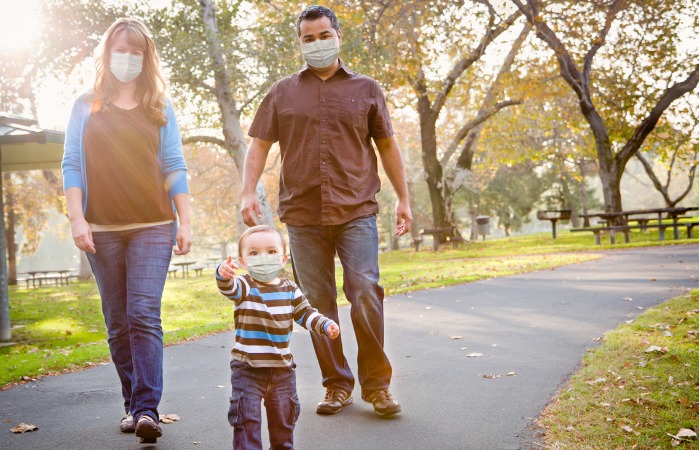
As medical experts learn more about how COVID-19 is transmitted, researchers are still trying to determine how well face coverings can prevent the spread of COVID-19. In spite of rapidly changing information about safety measures during the pandemic, health organizations still recommend wearing masks.
In June, the Centers for Disease Control and Prevention (CDC) issued guidelines instructing people to wear masks over their mouth and nose when in public spaces or where it’s hard to maintain social distance. Those guidelines differ from recommendations from the World Health Organization (WHO), which advises the use of medical masks for health care workers but says the widespread use of non-medical face coverings is not yet supported by high-quality scientific evidence.
There is ongoing discussion among medical professionals, researchers, and health care organizations about the effectiveness of face coverings. The CDC says that COVID-19 can spread from respiratory droplets produced when a person with the virus coughs, sneezes, or talks. The droplets may transmit the virus if they reach the mouth or nose of a person who is nearby. It also may be possible to contract the virus by touching a surface that holds contaminated droplets on it then touching the mouth, nose, or eyes.
Experts do agree that coronaviruses like COVID-19 are transmitted by inhaling droplets from someone who has the infection. Masks can reduce the number of infectious viral particles that people exhale into the environment. A body of evidence from countries where more people are wearing masks and the rate of infection is low makes a strong case for wearing masks during a pandemic.
But researchers and various health organizations do not yet agree on how easily the virus transmits through the air. Experts say they are unsure about exactly how it spreads from surfaces or how often people who have the virus – but show no symptoms – can transmit the virus. So far, they have been working with information about other coronaviruses, such as the Middle East respiratory syndrome (MERS) and severe acute respiratory syndrome (SARS).
New Data
According to some research, viral droplets are too heavy to travel more than about three feet. The 6-foot social distancing guideline is based on that finding. However, other data suggest that they can travel 23–27 feet in certain environments. Airborne particles are much smaller than droplets and can linger in the air for longer. Air currents also can carry them greater distances.
The CDC recommends that people wear cloth face coverings when leaving their homes, regardless of whether they have fever or symptoms of COVID-19. They advise not placing face coverings on young children under age 2, anyone who has trouble breathing, or is unconscious, incapacitated, or otherwise unable to remove the mask without help.
The WHO has given more specific recommendations. Outside of clinical settings (where all heath care workers and patients must wear medical masks), they encourage the use of non-medical fabric masks in areas where there are many cases of COVID-19 and for the general public where social distancing is difficult. This includes public transportation, shops and restaurants, and other confined or crowded environments. The WHO says any person with even mild possible virus symptoms should wear a mask. It makes the same recommendation for anyone caring for people with suspected or confirmed cases of COVID-19, for people age 60 or older, and anyone with an underlying health condition.
As an advisory in favor of overall caution, the WHO issued this statement:
“WHO has updated its guidance to advise that to prevent COVID-19 transmission effectively in areas of community transmission, governments should encourage the general public to wear masks in specific situations and settings as part of a comprehensive approach to suppress” COVID-19 transmission.
On the Side of Caution
Rachael Lee, MD, assistant professor in the UAB Division of Infectious Diseases, is UAB Medicine’s health care epidemiologist. She emphasizes the importance of wearing a mask, adding that the effort to prevent transmission of the virus is most successful when everyone follows the recommendations.
“With a new pathogen like COVID-19, the medical community needs accurate studies to answer key questions such as recommending facemasks for the general public,” Dr. Lee says. “Recent modeling has shown that consistent facemask use could significantly reduce transmission of COVID-19 and prevent further disease waves. However, the effect is greatest when 100% of the public wears facemasks.”
The majority of health care experts currently agree that, during a pandemic, it is difficult to study exactly how viruses are spread. For that reason, even without conclusive evidence of how effective masks might be, health organizations recommend choosing caution. Heath care professionals may not yet know the “why” behind the mask, but they do ask everyone to embrace the “why” behind caution regarding public health matters.
To comply with The Joint Commission and Centers for Disease Control and Prevention guidelines, as well as a city of Birmingham order, all employees, patients, and visitors are required to wear a mask or face covering inside and outside all UAB Medicine facilities. Learn more about our policy here.
Learn more about the CDC’s guidelines on face coverings here.
